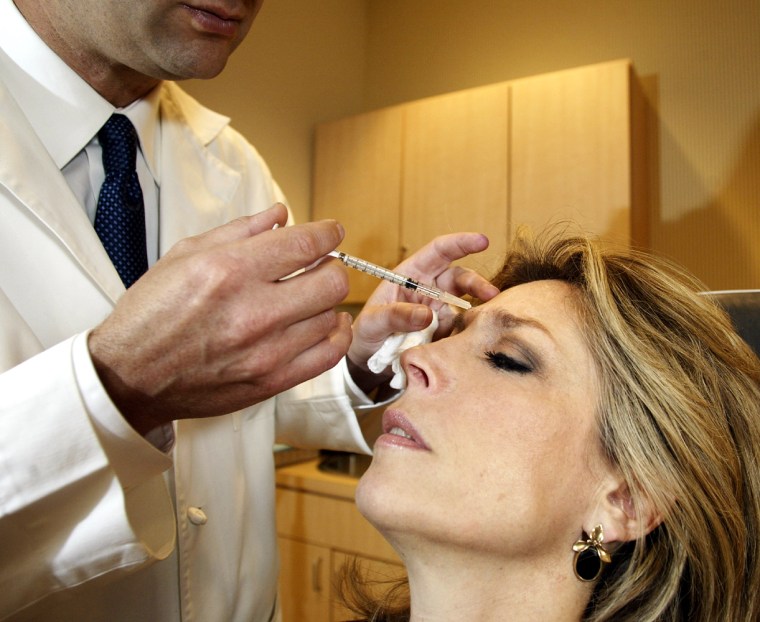When the remake of “The Stepford Wives” opens in theaters on Friday, the film will revisit themes of perfection and beauty that were a part of the cultural landscape long before the publication of the 1972 Ira Levin best seller and the 1975 film that followed.
But what's different this time is the way in which reality has trumped the fantasy. For more and more self-image-conscious Americans and their counterparts around the world, the most dramatic cosmetic procedure isn't physical, it's attitudinal — not a change of appearance, but a change in opinion about changes of appearance.
What made the original “Stepford Wives” such a horror-filled hoot — its characters' relentless pursuit of vigor and pulchritude in a media-soaked society — now has a pertinence starkly different from that in the mid-’70s, ringing truer than ever in today's airbrushed, nip-and-tuck, makeover-mad world.
It's apparent in everything from the dramatic rise in cosmetic surgical procedures to the television dramas on those makeover procedures, from the relentless drive for home improvement to the increasing inclination for persons to seek younger and younger mates.
Stepford World is a very real place. Being something brand new as a hedge against advancing age is a mission that starts with our bodies and extends to our relationships, our sex lives, even our homes. The reason's all too simple: We've seen the future, and we want to make some changes before we get there.
It's nothing new by any stretch, of the skin or the imagination. The 1996 film “The First Wives Club,” based on Olivia Goldsmith's 1992 novel, featured characters bent on revenge against husbands who abandoned them for younger spouses. The satire took dead aim at such treatments as collagen injections for lip-plumping and other procedures done with the intent of finding and keeping husbands through maintaining a physicality straight out of an Alberto Vargas painting.
And Fernando, the fiercely cosmeticized character played by Billy Crystal on NBC's “Saturday Night Live” in the ’80s, came close to getting the current mood right: “It's better to look good than to feel good.”
Makeover for the body
Americans, more and more consumed with at least looking their best, are signing up for elective cosmetic surgeries in record numbers. More than 8.7 million cosmetic surgical procedures were performed in 2003, according to American Society of Plastic Surgeons (ASPS) records.
The biggest category of growth was in non-invasive procedures like microdermabrasion and Botox injections, which increased by about 11 percent in 2003 from the year before, according to a survey by the American Academy of Cosmetic Surgery.
Other popular procedures included liposuction, rhinoplasties (nose jobs), chemical peels, laser hair removal and rhytidectomies (face lifts), which increased in 2003 by 46 percent over 2002, according to a survey by the American Academy of Facial Plastic and Reconstructive Surgery.
Such transformations span the ages. The American Society for Aesthetic Plastic Surgery reported in 2002 that men and women 65 and older were 5 percent of those getting cosmetic procedures, but that the number of people in that demographic seeking cosmetic procedures had gone up by more than 350 percent since 1997.
Teenagers — those eternal victims of peer pressure — are hardly immune. According to ASPS statistics, cosmetic surgical procedures on those 18 years and younger went up by 24 percent between 2000 and 2002.
The rush to tweak what nature provided is reflected in the appeal of such television shows as FX's "Nip/Tuck," the cosmetic-surgery series that begins its second season June 22.
Despite the number of surgery-related organizations with “American” in their names, the trend doesn't end at the water's edge.
Italian TV viewers, for example, have been lately fascinated by “Scalpel!: Nobody's Perfect,” a show that brings a patient's cosmetic surgery up close and personal for onlookers including family members, significant others and a studio audience. The show is broadcast by Italia 1, the network owned by Italian Prime Minister Silvio Berlusconi, who himself underwent a cosmetic procedure last year.
Makeover for the relationship
Makeovers don't stop at the physical, either; transformation extends to the interpersonal. The rules of attraction aren't what they used to be. With relationships between older women and younger men becoming more and more accepted, Mrs. Robinson from “The Graduate” would feel right at home these days.

Such chronologically lopsided celebrity pairings as Demi Moore (she's 41) with Ashton Kutcher (he's 26) — years after Tim Robbins (now 44) wed Susan Sarandon (57) — are the celebrity stamp of approval that's no doubt hastened their acceptance in the mainstream.
(Not that the reverse doesn't happen. Not long ago Jack Nicholson, now 67, kept romantic company with Lara Flynn Boyle, now 34. More recently, Harrison Ford, 61, has been a Hollywood item with Calista Flockhart, 39.)
Thanks to numerous pharmaceutical developments in recent years, the potential for makeover extends to that very fundamental element of the relationship — sex. A range of products from Viagra to Levitra to Cialis have been created to effectively treat erectile dysfunction.
Curiously, there appear to be fewer options for women, although testosterone, the male sex hormone, is being prescribed to boost the sex drive for women (though there are conflicting medical opinions as to how well it works).
Makeover for the home
The penchant for the new extends to where we live. The proof's in the popularity of home-improvement stores. Home Depot, a market-share leader, had more than $64 billion in sales in 2003. It's also apparent in the popularity of home-makeover shows like the popular ABC television program “Extreme Makeover: Home Edition,” in which contractors give a home a full makeover in the course of one (not real-time) episode.
The BBC America TV program “Changing Rooms” is “Extreme Makeover” with British accents, with a team of designers transforming a room's layout and color every week. And Waveguide, an online guide to British TV and radio news, reported in April that the town of Castleford, West Yorkshire, will get a face lift. Architects and designers are to build a new bridge and other environmental improvements to prepare for a new TV makeover series set for British television in 2005.
Is it all about the numbers?
While the chase after Ponce de Leon's storied “fountain of youth” is measurable, the notion of beauty is one of the most undefinable things in nature, which doesn't necessarily mean it's elusive. Newsweek reported in November on Dr. Stephen Marquardt, a former plastic surgeon in Huntington Beach, Calif. Marquardt maintains that ideal beauty can be reduced to a facial geometry based on the so-called Golden Ratio — the recurring ratio of 1.618:1, a standard that Newsweek said “shows up on everything from snail shells to tree leaves.”
“People have tried to understand a beautiful face, but what the hell is it?” Marquardt said. “It’s an image that is mathematically quantifiable. All life is biology, all biology is chemistry, all chemistry is mathematics.”
The magazine reported that Marquardt created technology for digitally scanning faces and then interfacing the resulting image with computers consistent with his mathematical formula. Cosmetic surgeons could then use the formula as a guide for their surgical procedures.
But our society's pursuit of some existential ideal is ultimately less about numbers than about the purely emotional, the way we feel when looking in the mirror of our lives.
Maybe Berlusconi's son, Piersilvio, put it in perspective in a Washington Post interview. His reference was to the reasoning behind the “Scalpel!” program, but the statement applies equally to what people choose to watch and how people choose to live.
“If one doesn't like what one sees,” he said, “you change channels ...”
